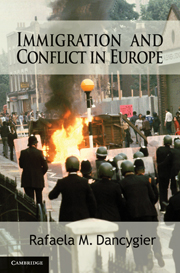Book contents
- Frontmatter
- Contents
- List of Figures and Tables
- Acknowledgments
- PART I GENERAL INTRODUCTION AND THEORETICAL FRAMEWORK
- PART II INTRODUCTION TO PART II
- PART III INTRODUCTION TO PART III
- 5 Immigrant–Native Conflict in Two London Boroughs
- 6 Two Faces of Immigrant Conflict in Two Midlands Cities
- PART IV INTRODUCTION TO PART IV
- 9 Conclusion
- Appendix A Coding Large-Scale Instances of Immigrant–Native and Immigrant–State Violence
- Appendix B Data and Variables: Immigrant Turnout
- References
- Index
- Titles in the series
6 - Two Faces of Immigrant Conflict in Two Midlands Cities
Published online by Cambridge University Press: 17 November 2010
- Frontmatter
- Contents
- List of Figures and Tables
- Acknowledgments
- PART I GENERAL INTRODUCTION AND THEORETICAL FRAMEWORK
- PART II INTRODUCTION TO PART II
- PART III INTRODUCTION TO PART III
- 5 Immigrant–Native Conflict in Two London Boroughs
- 6 Two Faces of Immigrant Conflict in Two Midlands Cities
- PART IV INTRODUCTION TO PART IV
- 9 Conclusion
- Appendix A Coding Large-Scale Instances of Immigrant–Native and Immigrant–State Violence
- Appendix B Data and Variables: Immigrant Turnout
- References
- Index
- Titles in the series
Summary
As the histories of Tower Hamlets and Ealing have demonstrated, violent intergroup strife and organized resistance against migrant newcomers are the likely outcomes when immigrant groups use their electoral clout to claim their share of scarce state resources. But what happens when immigrant groups are in no position to make politically credible demands? This chapter contrasts two cities in the British Midlands, Birmingham and Leicester, to show how variation in immigrants' local political capital – holding available economic resources relatively constant – leads to profoundly different relations between immigrants and natives on the one hand, and immigrants and the state on the other.
Both cities reacted to the large inflow of ethnically distinct postcolonial immigrants with hostility. In Birmingham, however, this hostility proved insufficient to engender support for collective resistance. Despite repeated efforts, xenophobic parties did not make significant electoral inroads, local anti-immigrant pressure groups failed to gain momentum, and riots or organized street violence between immigrants and natives did not characterize intergroup relations. The resistance and violence that did occur in Birmingham was of a different kind: Politically excluded immigrant-origin minorities found themselves in conflict with the local state and its institutions. Leicester, by contrast, responded to the large inflows of predominantly Indian immigrants – who were soon incorporated politically – with fierce and organized resentment. The city became a National Front stronghold and defenders of the newcomers' presence and physical safety engaged in antiracist campaigns as well as street battles with their racist opponents.
- Type
- Chapter
- Information
- Immigration and Conflict in Europe , pp. 178 - 218Publisher: Cambridge University PressPrint publication year: 2010

